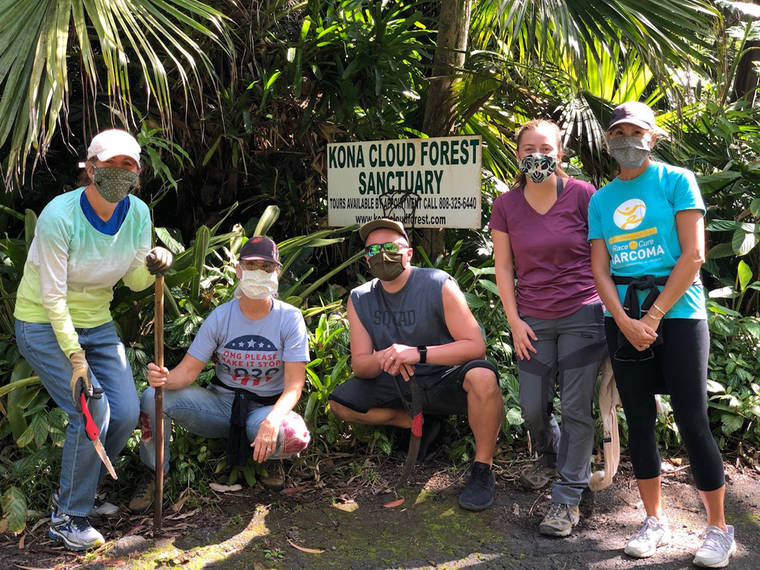Spring in Kona’s unique tropical cloud forests and East Hawaii’s rain forests is heralded by abundant new growth of ferns, especially our endemic Cibotium tree ferns.
If you want to get a sense of what life was like during the time of the dinsaurs, visit the Kona Cloud Forest above Kailua-Kona. The area abounds with ferns that once were dominant millions of years ago. Hawaii Volcanoes National Park is also another region famous for forests primarily composed of our native Cibotium, or hapuu; Sadleria, or amaumau ferns; and ohia.
This year, volunteers sponsored from Old Navy are helping beautify the Kona Cloud Forest Sanctuary area roadsides and trails along Hao Street and Kaloko Drive. Money received for their work is being donated to the Project Hawaii to fund homeless keiki Easter baskets. To get more information about the project and how to help, check out www.helpthehomelesskeiki.org. You also can contact Kym Gentry Peck at kymgpeck@gmail.com or call her at (808 494-5193).
As you experience our upland forests, take note of the many types of ferns.
Ferns are a good example of a whole family of plants that are not often represented in our gardens. It’s not that they can’t be grown, but that we don’t give them much of a try. Ferns, in general, are free of insect and disease problems. They require very little fertilizer but do require moisture and shade from intense sunlight.
We have hundreds of ferns, native and introduced to Hawaii, but this is just a fraction of the more than 9,000 species found throughout the world.
A side benefit of ferns is that some are edible. Some examples are the swamp fern and “warabi.”
The swamp fern, Ceratopreris thalictroides, found growing wild in moist areas can be eaten either raw or cooked. Our native hapuu has an acrid substance so strong that the new leaf“fiddle” must be boiled outside for 30-45 minutes since they contain irritating fumes. After boiling, the outer skin is peeled off and the interior portions are soaked in fresh water. The water is discarded and replaced with fresh water each day. This procedure takes 3-4 days. Then they can be stored in the water and refrigerated for several months.
Fern shoots add an exotic touch to vegetable and pork dishes along with bamboo shoots. Many edible ferns also are high in Vitamin A.
In the landscape, ferns give that ultra tropical look that really makes a garden special. The most striking effect, by far, is created by the tree fern types.
In Hawaii, our native Cibotium are being used in the landscape but are slow growing and becoming scarce. The hapuu ii, or male fern, usually dies after transplanting. The so-called female fern can be transplanted before new leaves emerge in the spring, but often will die when planted out of their natural wet habitat.
To establish them, plant in a rich organic soil and keep them moist and shaded. Within a couple of weeks, they will begin developing large airy leaves and roots. A shady spot protected from wind is best. They should be watered on the trunk and at the base frequently.
Live stumps can sometimes be purchased locally. Do not remove ferns from the forests. It is illegal without permission. They are becoming rare in some areas because of cutting and removing.
Some other species of tree ferns are carried in a few local nurseries. There are many types of tree fern available.
When planting ferns, be sure to enrich the planting sight by adding peat moss or rotted compost and some well-rotted manure to the existing soil. A good ratio is about 50% peat, 40% cinder and 10% well-rotted manure. New plants should be watered daily until they are established.
Ferns are sensitive to chemical fertilizers so use them sparingly. It is better to use organics such as sewage sludge or rotted manures. Fertilize about once every 2-3 months for best growth. Avoid liquid insecticides and fungicides, for they too will burn. Diluted wettable powders are safer. Ferns also are extremely susceptible to herbicides, so be careful.

